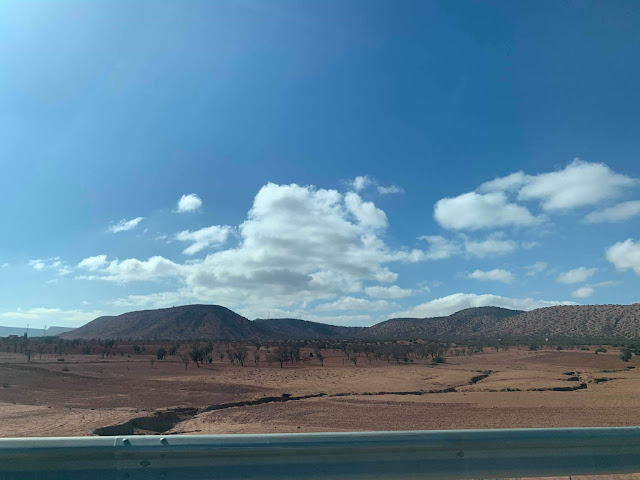GWI: Focusing in on Morocco
GWI:
Focusing in on Morocco
I have just
come back from a week in Morocco, during which I drove 4 hours across the
country. I was amazed at the stark contrast in landscape from what I am used to
in the UK, especially from where I live in the Cotswolds. As a result of this trip, I
have decided to focus this week’s blog specifically on Morocco. I will be
focusing on some of the topics that have been discussed in the past two blogs, linking them to explicit examples.
Morocco is
situated on the north west coast of Africa, just a short ferry away from the
south end of Mainland Europe. It is the 10th most developed country
in Africa with an HDI comparable to Iraq and India (United Nations HDI Reports, 2017).
22.1% of the land in Morocco is arable (excluding the Western Sahara), 43% of
arable land is devoted to cereals, 7% to plantation crops and 42% was fallow (Nations
Encyclopaedia). Fallow farmland is ploughed and harrowed but left for a
period without being sown in order to restore its fertility. Agriculture
accounts for 16% of the GDP of Morocco.
There
has been a history of dams and irrigation projects since French colonisation
and these projects have continued with various levels of success since independence.
In traditional areas, predominantly occupied by subsistence farmers, irrigation
systems consist of springs and wells or diversion of streams. Where Morocco’s
major rivers flow, mainly in the north west of the country that receives a Mediterranean
climate, dams and irrigation projects account for over 50% of the country’s water
resources (Nations
Encyclopaedia). There is a history
of grants and development funds to finance irrigation projects, often in the
more arid regions of Southern Morocco. In 1994, the Kuwaiti Economic
Development Fund lent $60 million, a loan that served over 200,000 small farmers.
A
photo I took on my trip, which I believe illustrates the harsh reality of the
landscape
Morocco
has over 3.2 million acres of irrigated agricultural land, and to encourage
modernisation of traditional sectors, the Agricultural Investment Code of 1969 was
set in place to ensure that farmers of irrigate land could meet an efficiency quota
and would risk losing their land if not (Daoud
and Engler, 1981).
There are
6 main hydrogeological areas in Morocco, containing 103 aquifers of variable
importance. All of the aquifers are experiencing some degree of stress, due to
a combination of over-abstraction and low or diverted rainfall resulting in a reduced
recharge rate (Earthwise
Hydrology, 2019). The quality of the groundwater in these aquifers are also
declining from saline intrusion and nitrate fertiliser pollution. One method of
management for some of the more ‘development-critical’ aquifers is artificial
recharge. This is carried out by the Moroccan Department of Water and has the ability
to restore the balance of the aquifers and also slow down the progress of
saline intrusion (CIRAD,
2014). At a national level there are 24 aquifers that are so overexploited
that artificial recharge is the only way to mitigate the deficit.
In Souss‐Massa,
a southern region of the country, assessments into the risks of soil degradation
from the saline groundwater are being completed. The semi-arid and arid regions
that require irrigation are also more susceptible to saline intrusion as the
increased temperatures produce high evaporation in the soil, concentrating any saline
soil solution (El Oumlouki et
al, 2018). Whilst sustainable management strategies are available, the
conditions are harsh, and it is difficult to implement them with low funds. One
of the strategies that can provide improvement with minimal change is employing
cyclic strategies to irrigate crops in a rotation. The crops are irrigated with
freshwater until they reach a salt-tolerant life stage, they are then
subsequently irrigated with the saline water. However more fundamentally, management
strategies should focus more on the source of the problem which is the
human-led overuse and overexploitation (FAO,
2009).
I hope
this blog has provided a more specific look into a few of the topics we have
already discussed. As always, thanks for reading!

Comments
Post a Comment